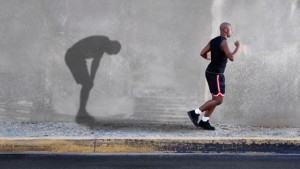An Athlete with Osteoporosis
I remember hearing a comment during a conference that I attended that for every hour of flying time a jet requires 18 hours of servicing. When I shared with a few friends that are pilots they quickly agreed and weren't surprised.
And hopefully most of us recognize how much more valuable we are than a plane. Yet, we fail to make the same investment in our health and care. Specifically when it comes to our rest, recovery and regeneration.
Sometimes it can seem as though all we do is push, push and push some more. We look to add more load to the bar. We want an extra rep or two. We seek extra distance or faster times.
And I get it. I want these things too. But we have to be honest with ourselves. And by that I mean to look at our own lives and work ethic and answer the question 'Am I doing enough? And am I going intensely enough?'. Maybe we need an outsider to answer this for us.
Because here's the thing.
The person who does as much as they can and as hard as they can wouldn't think they need to take a break or slow down. Whereas the person who makes nominal efforts or investments in their health believes they are making huge efforts.
[caption id="attachment_5338" align="aligncenter" width="300"] Are we pushing hard enough? Or do we need a break?
And here's what typically happens with both groups of people.
The person going all-out, doing as much as they can doesn't see themselves as doing too much. They have always done this and it's not out of the ordinary. Their memories allow them to recall former years when they were leaner, stronger, faster and this drives them on an impossible quest for improvement.
And the other guy who does the minimal amount and holding back on his best effort will feel he's doing enough. He will believe he deserves more indulgences than are due because the same training history is not there or because he surrounds himself with others that don't want the best health and fitness.
Consider the story of Bobby Clay.
Clay is a track athlete for UK Athletics and has won the European Junior title and finished fourth at the Junior World Championships.
Clay was always someone that pushed for more. If a workout called for a certain distance she did that distance plus a little extra. If the training program called for a certain frequency she might find the time to add in an extra workout.
All the while of pushing the intensity envelope Clay was under-fueling herself. She says in her article that she didn't have an eating disorder but that she realized the benefits of under-fueling and was ok with it. In other words, by under-fueling she was able to maintain a lower body mass. And this was a benefit when moving the body in a running race.
She had all the pieces of the puzzle for the female athlete triad of over-training, under-fueling and amenorrhea. And soon found herself in the doctor's office as her parents were concerned about her health and potential loss of fertility.
She was told everything was ok and continued on with the same training and nutritional approach.
Then she broke her foot. While she was swimming!
I don't think I've ever heard of someone breaking their foot while swimming. The body is suspended by water and the weight bearing joints don't have to withstand nearly the same forces as they do on land. In fact, swimming is often a great exercise choice for those with injuries, specifically to weight bearing joints.
However as an athletic (world champion) teenager Clay managed to break her foot while swimming.
A subsequent DEXA scan confirmed that Clay did in fact have osteoporosis.
She is now on the road to recovery with hormone replacement therapy.
I remember John Berardi, of Precision Nutrition, sharing something regarding training and recovery. And he said that the time when you least feel like you can afford to take a break, that is when you need a break the most.
Going forward it's still ok to want the best. But be reasonable with yourself. Don't compare your current self to the version from 20 or 30 years ago.
And in order to determine whether you're over-doing it or not consider the company you keep. Do you hang out with athletic freaks that exercise intensely every day? Or are your friends more likely to binge watch a series on Netflix than make plans for hiking?
Lastly, trust those around you. Close friends and family members will recognize the signs often before we do. Trust that they want the best for us and if they suggest easing up a bit it's not to compromise our results but the opposite.
When you subscribe to the blog, we will send you an e-mail when there are new updates on the site so you wouldn't miss them.

Comments